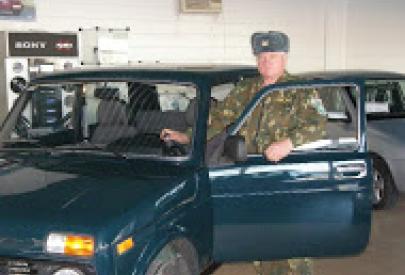Anatoly Khludnev, Stepnoi State Nature Reserve, Astrakhan, Russia

Anatoly Khludnev is Director of the Stepnoi State Nature Reserve in the Astrakhan region of Russia. He was an officer in the Russian Army and his is now a retired lieutenant colonel.
The editor of Saiga News interviews Anatoly Khludnev
For the last 10 years, Anatoly has been devoting all his time and energy to the conservation of this unique antelope from the steppes of the north-western pre-Caspian region.
Editor: When did you become interested in saigas for the first time?
I heard about saigas in my earliest childhood, however I managed to see them for the first time just by good fortune when I was in the 7th form at school. I remember that day very well. I was part of a group of villagers who were out winter fishing. All of a sudden a group of animals running very fast came in sight on the crest of the hill and all the adults shouted: "Saigas!!!". I managed to have a good look at these animals, all of them were in ""winter dress"" and the group consisted of about 500 animals. I could see males with horns amongst them.
Editor: When did you begin to work on saiga conservation?
After I completed my military service in 2000, I was offered a job in saiga protection, as the Director of the Stepnoi Nature Reserve. Having assembled a team of nature protection enthusiasts, we developed proper security for saigas, persistently carried on awareness work among the local population and rigidly controled any attempted poaching within the Stepnoi Nature Reserve and in the adjacent area.
Editor: What is your usual day like?
I do not consider myself an armchair worker, so I do my best to do all my paperwork as soon as possible and most of my time is spent out on duty to ensure our continuous presence in the reserve. My working day is filled with different events. Alongside performing our direct official duties, our team helps with scientific research conducted by students and scientists visiting our reserve.
We have participated several times in the filming of popular-science films created by the TV- channels "STS", "ZOO TV", and by a film crew from Great Britain. A member of the Steering Committee of the Saiga Conservation Alliance, Aline Kuhl, was a scientific consultant for the UK film.
We often conduct tours for schoolchildren, because if we foster care for nature early in their life, we will win in the future. Every year in spring we conduct tours with foreign tourists from Great Britain, Germany, Austria and Switzerland.
Editor: Can you tell us any interesting story about saiga?
For sure!!!!
There are very many stories but most of all I was amazed by a scene which I saw at the very beginning of my career. One fine day I was an eyewitness to adult saigas' care for their youngsters. It was in June, in the period of ""upbringing"" of young saigas. A migrating herd was moving through the nature reserve, females were leading the way followed by small saigas -- a ""kindergarten"" -- and 5-6 adult males brought up the rear. These males would not let the youngsters lag behind and get lost; they would carefully lift the tired little things with their noses and took care of them in every way. Later, repeatedly watching such herds, I named such males ""nannies"".
Editor: What are the major problems in your work?
I consider underfinancing of law enforcement and the lack of interaction with the environmental agencies of the Republic of Kalmykia to be the key problems.
Editor: And how can the impediments in your work be removed?
I believe that the nature conservation problems are resolvable, but that they should be tackled at the regional level or above, by officials of the Astrakhan region and the Republic of Kalmykia.
Editor: What is the best thing in your work?
A well-coordinated team where the notions of Honour and Conscience are not empty words!!! Striving by all team members to work with their hearts and souls, each of us, is the way to get results! And for us the result is to help saigas survive in these conditions, which are anything but simple.
Editor: What are the prospects for saiga conservation? What should be done in the first place to help this species survive?
At this moment, poaching persists in the Republic of Kalmykia. And if we do not create a specialized Federal squad the future of the Russian saiga population is under serious threat.
Editor: You have been working in the field of nature conservation for more than a decade. What has changed over these years and what are the current trends for conservation?
Changes have mainly taken place within the Astrakhan region; poaching by the local population has been completely eradicated. Mass poaching by Kalmykian residents has also reduced, yet so far we cannot talk of a complete cessation of saiga poaching in Kalmykia. We managed to stabilize the population at about 20,000 in 2000- 2007. After the Federal unit was disbanded in Kalmykia and the powers for wildlife conservation were passed to regional control, nature protection collapsed. There was practically no protection for nine months in 2008. For this reason, in 2010 the saiga population dropped to 12,000 animals.
Currently, the Russian saiga population is no larger than 7,000 animals.
